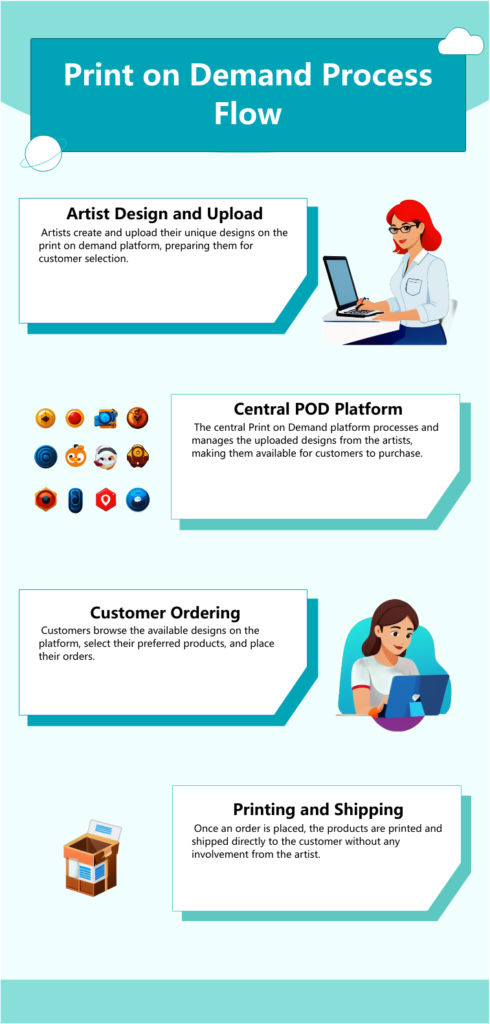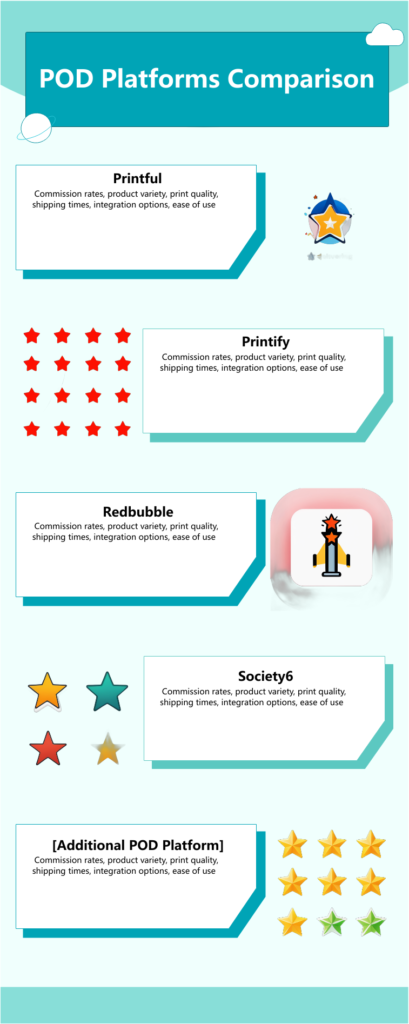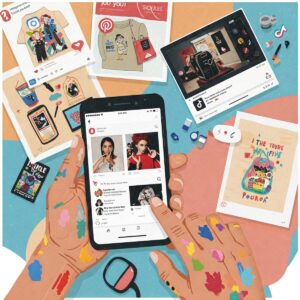Print on demand is a business model that allows artists to sell custom merchandise featuring their artwork without having to manage inventory, handle shipping, or deal with manufacturing. It’s essentially a partnership between you (the artist) and a POD service that prints and ships your designs on products only after they’ve been purchased. This revolutionary approach to selling art merchandise has opened doors for countless artists to earn income from their work without the traditional barriers of production costs and inventory management.
Key Points:
- Print on demand lets artists sell merchandise without inventory
- Products are only created after a customer places an order
- POD services handle printing, packaging, and shipping
- Artists earn royalties from each sale
- Perfect for passive income streams
- Works with many products: clothing, mugs, phone cases, and more
What is Print on Demand and How Does it Work?

Print on demand (often abbreviated as POD) is a retail fulfillment method where products are created only after a customer makes a purchase. Here’s how the process typically works:
- You create artwork and upload it to a POD platform
- You select which products to feature your designs on
- You set your prices and profit margins
- The POD platform lists your products for sale online
- When a customer places an order, the POD service prints your design on the product
- The service packages and ships the order directly to your customer
- You receive a royalty for the sale
This model differs dramatically from traditional merchandise production, where you would need to order products in bulk, store them, and handle shipping yourself. With print on demand, there’s no upfront investment in inventory, no storage concerns, and no fulfillment headaches.
Benefits of Print on Demand for Artists
Print on demand offers numerous advantages for artists looking to monetize their work:
No Inventory Risk
Since products are only created after they’re purchased, you don’t risk losing money on unsold inventory. This removes one of the biggest barriers to entry for artists wanting to sell merchandise.
Low Startup Costs
You can begin selling products with virtually no upfront investment other than creating your designs. This makes POD accessible to artists at any stage of their career.
Time Efficiency
By outsourcing production and shipping, you can focus on what you do best – creating art. The POD service handles the time-consuming aspects of order fulfillment.
Product Variety

Most POD services offer a wide range of products, from apparel to home decor. This lets you experiment with different product types to see what resonates with your audience.
Scalability
Your business can grow without the proportional increase in workload that would come with traditional production methods. Whether you sell 10 or 1,000 items per month, your workload remains relatively stable.
Popular Print on Demand Platforms for Artists
Several platforms specialize in providing print on demand services for artists. Each has its own strengths, product offerings, and commission structures.

| Platform | Best For | Commission Structure | Integration Options |
|---|---|---|---|
| Printful | Custom branding | You set prices | Shopify, Etsy, WooCommerce |
| Printify | Product variety | You set prices | Shopify, Etsy, eBay |
| Redbubble | Ready marketplace | Platform sets base price | Standalone platform |
| Society6 | Art community | Platform sets base price | Standalone platform |
| Zazzle | Customization | You set royalty % | Standalone platform |
| SPOD | Fast shipping | You set prices | Shopify, Wix, WooCommerce |
When choosing a platform, consider factors like print quality, shipping times, product selection, and whether you want to integrate with your own website or sell on an established marketplace.
Creating Designs for Print on Demand Success
The quality and marketability of your designs will largely determine your success in the print on demand world. Here are some tips for creating designs that sell well on merchandise:
- Consider the product: Different products require different design approaches. A design that works well on a poster might not translate effectively to a mug or t-shirt.
- Use the right files: Most POD services prefer high-resolution PNG files with transparent backgrounds. Vector files (SVG, AI, EPS) are ideal for designs that need to be scaled.
- Color considerations: Be aware that monitors display colors differently than printed products. Consider how your design will look when printed using the CMYK color space rather than RGB.
- Keep it simple: Overly complex designs often don’t translate well to merchandise. Clean, bold designs typically perform better, especially on smaller items.
- Create mockups: Use the platform’s mockup generators or create your own to visualize how your designs will look on products before listing them.
“The key to print on demand success is creating designs that connect with specific audiences while looking professional on a variety of products.”

For a deeper dive into creating digital art suitable for POD products, our previous guides can help you master the fundamentals.
Marketing Your Print on Demand Products
Having great designs is only half the battle – you also need to effectively market your POD products to generate sales. Here are proven strategies:
Social Media Marketing
Platforms like Instagram, Pinterest, and TikTok are visual mediums perfect for showcasing your merchandise. Create content showing your products in real-world settings or being used by satisfied customers.
Email Marketing
Build an email list of fans and customers to notify them of new designs and special promotions. This direct communication channel remains one of the most effective marketing tools.
Niche Targeting
Rather than trying to appeal to everyone, focus on specific niches or communities who will resonate strongly with your art style or message. A passionate niche audience often generates more sales than a lukewarm general audience.
Leverage SEO
Use relevant keywords in your product titles and descriptions to help potential customers find your products through search engines. Research what terms people use when looking for products like yours.
Collaborate with Influencers

Partner with micro-influencers in your niche to showcase your products to their audiences. Often, smaller influencers with highly engaged followers deliver better results than celebrities with millions of followers.
For more guidance on selling your art online, our comprehensive guide covers additional marketing strategies specifically for artists.
Legal Considerations for Print on Demand Artists
Before diving into print on demand, be aware of these important legal considerations:
- Copyright ownership: Only use artwork you’ve created or have the rights to reproduce commercially. Using others’ intellectual property can lead to legal issues.
- Trademark infringement: Avoid using trademarked names, logos, or characters in your designs without permission.
- Rights to your uploads: Read the terms of service for any POD platform you use to understand what rights you’re granting them to your artwork.
- Tax obligations: Income from POD sales is taxable. Consult with a tax professional about your specific situation, especially if you’re selling internationally.
- Business structure: Consider whether operating as a sole proprietor or forming an LLC or other business entity makes sense for your situation.
For comprehensive legal advice, consult with an attorney who specializes in intellectual property and small business law. External resources like the U.S. Copyright Office provide valuable information about protecting your creative work.
Maximizing Your Print on Demand Profits
To make your print on demand business as profitable as possible:
- Price strategically: Research competitive pricing in your niche while ensuring your profit margins are sustainable.
- Create design collections: Themed collections can encourage multiple purchases and create a coherent brand identity.
- Analyze sales data: Use analytics to identify your best-selling designs and products, then create more similar items.
- Seasonal planning: Prepare seasonal designs well in advance to capitalize on holiday shopping periods.
- Test different products: Some designs may perform better on certain products. Experiment to find the optimal combinations.
- Quality control: Order samples of your products to ensure print quality meets your standards before promoting them heavily.
- Cross-promotion: If you sell on multiple platforms, encourage followers from one channel to check out your offerings elsewhere.
Remember that consistency and persistence are key to building a successful print on demand business. Most artists don’t see immediate success, but with time and strategic adjustments, your POD income can grow significantly.
The Future of Print on Demand for Artists
The print on demand industry continues to evolve with new technologies and market trends. Here are some developments to watch:
- Sustainable production: Eco-friendly materials and production methods are becoming increasingly important to consumers.
- Augmented reality previews: Some platforms are implementing AR features that let customers visualize products in their own space before purchasing.
- Direct-to-film printing: Advancing printing technologies are improving quality and expanding the range of possible products.
- Integration with NFTs: Some artists are exploring connections between digital art NFTs and physical merchandise through POD.
- AI design assistance: Artificial intelligence tools are emerging to help artists create variations of their designs optimized for different products.
Staying informed about these trends can help you position your print on demand business for future success.
Conclusion to What is Print on Demand
Print on demand offers a remarkable opportunity for artists to monetize their creativity without the traditional barriers of merchandise production. By understanding what print on demand is and how to effectively implement it in your art business, you can create a valuable income stream that works while you sleep. Whether you’re looking to supplement your existing art career or build a standalone business, POD provides the flexibility and scalability that traditional production methods simply can’t match.
Remember that success in print on demand requires a combination of compelling designs, strategic marketing, and continuous learning. Start small, test different approaches, and gradually build your POD business based on what resonates with your unique audience.
FAQs About Print on Demand
How does print on demand work?
Print on demand works by connecting your artwork with production partners who print and ship products only after a customer places an order. You create and upload designs, set prices, and promote products, while the POD service handles manufacturing, packaging, and delivery directly to the customer.
Which print on demand service is best for artists?
The best service depends on your specific needs. Printful and Printify offer more control and higher profits if you have your own store, while Redbubble and Society6 provide ready-made marketplaces with built-in traffic. Consider factors like print quality, product selection, shipping costs, and integration options when choosing.
Is print on demand profitable in 2025?
Yes, print on demand can still be profitable in 2025, though competition has increased. Success depends on creating unique designs for specific niches, effective marketing, and strategic product selection. Most successful artists focus on building a brand rather than trying to make quick sales with trendy designs.
What products sell best on print on demand?
T-shirts, mugs, phone cases, and posters typically perform well across most platforms. However, the best-selling products may vary depending on your artistic style and target audience. Test different products with your designs to discover what resonates most with your specific customers.
How do I set up a Shopify print on demand store?
To set up a Shopify print on demand store: 1) Create a Shopify account, 2) Choose and customize a theme, 3) Install a POD app like Printful or Printify from the Shopify App Store, 4) Connect your POD account to Shopify, 5) Upload your designs and create products, 6) Set your prices, and 7) Launch your store. Most POD apps offer detailed tutorials for the integration process.


